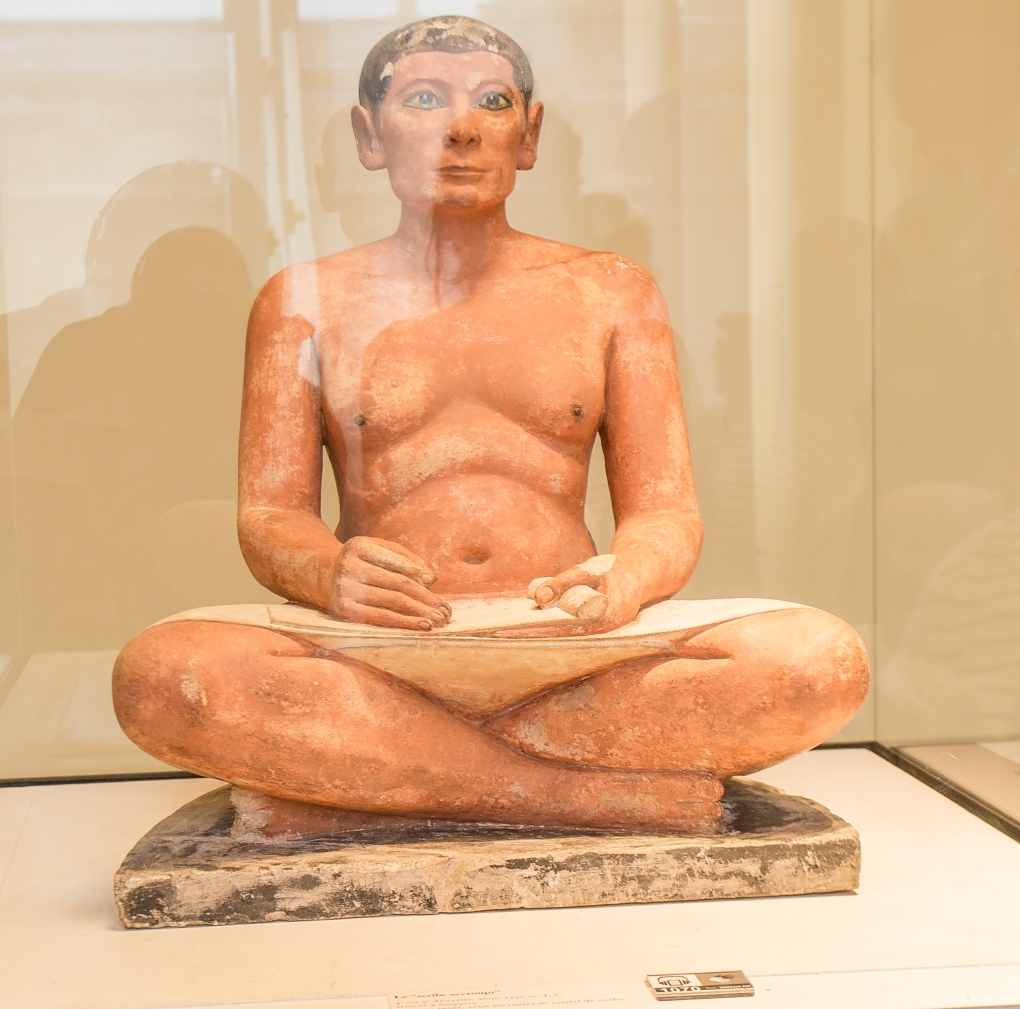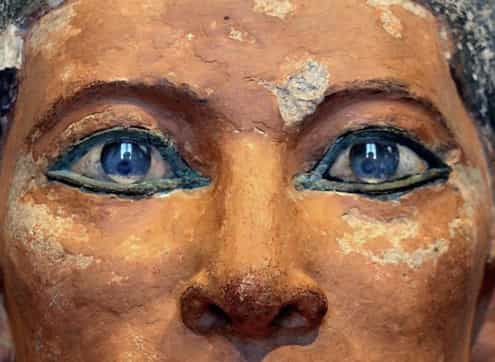The inlaid eye of the “Seated Scribe,” dating back to approximately 2600-2350 BCE, stands as a powerful testament to the extraordinary artistry and craftsmanship of ancient Egypt. This artifact, part of a larger statue, offers us a window into the sophisticated techniques and cultural practices of one of the world’s earliest civilizations. Crafted from red-veined white magnesite and rock crystal, the eye is an outstanding example of how ancient Egyptian artisans combined skill, material, and symbolism to create lifelike representations imbued with spiritual meaning.
Material and Craftsmanship: An Ancient Masterpiece
The eye’s composition is a masterclass in the use of available materials. The artisans chose red-veined white magnesite and rock crystal—precious materials that were highly valued in the ancient world for their rarity and beauty. The polished crystal was not just a decorative element; it served a functional role, simulating the appearance of the eye’s natural glimmer. To enhance its realism, the back of the crystal was coated with a material that mimicked the color of the iris, further contributing to the lifelike quality of the representation.

The precision required to craft such a small but intricate piece of art speaks to the advanced techniques developed by Egyptian craftsmen. The ability to manipulate and shape these materials with such skill reveals a deep understanding of both aesthetic beauty and the symbolism embedded in these works.
Symbolism and Cultural Significance
The inlaid eye was not merely a decorative element; it was an integral part of a statue designed to represent the “Seated Scribe.” In ancient Egypt, scribes held an esteemed position in society, known for their role in literacy, administration, and preserving knowledge. The scribe was often depicted in art with distinct features that emphasized their wisdom, intelligence, and social power.

The eye itself serves as a focal point, capturing the viewer’s attention and contributing to the lifelike nature of the statue. This lifelike representation was believed to be more than a mere portrait. Egyptians believed that statues had the power to house the spirit of the individual, and the precision and attention to detail in the creation of the eye ensured that the statue was imbued with life. By creating such realistic representations, artisans allowed the spirit of the scribe to reside in the statue, ensuring it would continue to fulfill its role in the afterlife.
Spiritual and Religious Practices
The creation of lifelike images in ancient Egypt was closely tied to religious and spiritual beliefs. The Egyptians placed great importance on the afterlife, and statues were often used in rituals and burial practices to honor the deceased and ensure their continued existence in the next world. The inlaid eye of the “Seated Scribe” reflects this cultural practice, symbolizing the connection between the material and spiritual realms.

By focusing on the details of the eye, which is often considered the window to the soul, the artisans created a medium through which the spirit of the scribe could be called upon. The realism of the eye ensured that the spirit would recognize the statue as its earthly counterpart, enabling the deceased to be revered in both life and death.
Insights into Egyptian Material Culture and Aesthetics
The preservation of the inlaid eye offers modern viewers a rare glimpse into the material culture and aesthetic values of the ancient Egyptians. It showcases not only the technical skill of the artisans but also the profound cultural and spiritual beliefs that shaped their creative practices. The fact that this object has survived for over four millennia is a testament to both its craftsmanship and its symbolic importance within ancient Egyptian society.

Today, the inlaid eye is a valuable artifact that continues to provide insights into the artistic traditions, spiritual practices, and social hierarchies of ancient Egypt. Its craftsmanship, symbolism, and significance make it one of the most remarkable examples of ancient Egyptian artistry, offering us an intimate connection with the past.
Conclusion
The inlaid eye of the “Seated Scribe” is more than just an artifact—it is a testament to the remarkable skill and cultural depth of ancient Egypt. Through its intricate design and symbolic significance, it offers a glimpse into the values, beliefs, and material culture of one of the world’s oldest civilizations. The eye reflects the artistry, spirituality, and craftsmanship that were central to Egyptian society, and its preservation allows us to appreciate the legacy of a civilization that continues to captivate the world today.

